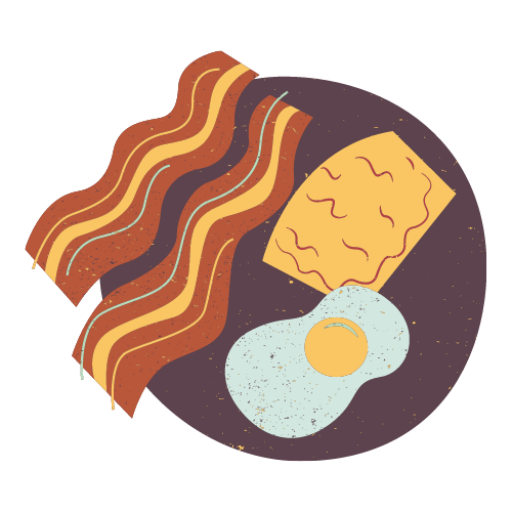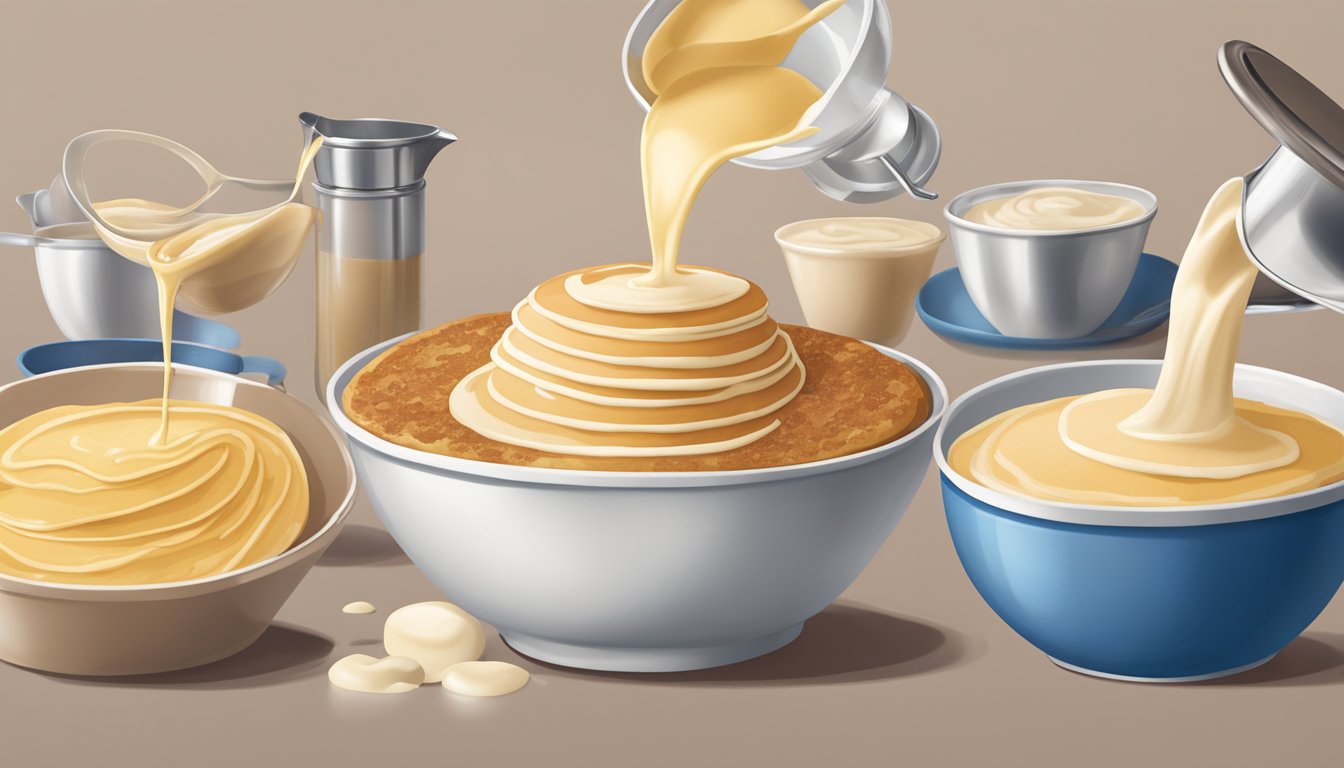IHOP has long been synonymous with pancakes, but their signature batter holds a surprising secret. The renowned breakfast chain uses its pancake mix in more than just flapjacks. IHOP’s pancake batter is added to omelets, creating a fluffier and lighter texture that sets their egg dishes apart.
This unexpected technique has been a topic of curiosity among IHOP patrons. The addition of pancake batter to omelets serves a dual purpose. It provides structure and heft to the dish while also incorporating leavening agents that give the omelet a unique lift. This method aligns with culinary practices where chefs add flour to omelet batter for similar reasons.
IHOP’s approach to pancakes themselves is equally meticulous. The chain has perfected a combination of ingredients and techniques over the years. From precise mixing methods to carefully controlled griddle temperatures, every step is designed to achieve the signature fluffiness that IHOP pancakes are known for.
The Origins of IHOP’s Signature Pancake Batter

IHOP, short for International House of Pancakes, has been serving its iconic pancakes since 1958. The restaurant chain’s signature pancake batter has become legendary over the decades.
IHOP’s original buttermilk pancakes quickly gained popularity for their fluffy texture and rich flavor. The company developed a proprietary pancake mix to ensure consistency across locations.
The exact recipe remains a closely guarded secret. However, it’s known that the batter contains a precise blend of flour, eggs, buttermilk, and leavening agents.
IHOP’s culinary team spent years perfecting the pancake batter formula. They aimed to create pancakes that were consistently golden brown, light, and satisfying.
One key to IHOP’s pancake success is the batter’s versatility. The company discovered it could be used in other menu items beyond just pancakes.
IHOP began incorporating its signature batter into dishes like omelets and French toast. This innovative approach helped create a unique flavor profile across the menu.
The pancake batter’s ability to enhance various recipes became a defining feature of IHOP’s culinary identity. It allowed the chain to differentiate itself in the competitive breakfast restaurant market.
Fundamental Ingredients in IHOP’s Pancake Batter

IHOP’s pancake batter contains a carefully selected blend of ingredients that contribute to its signature taste and texture. The combination of dairy products, leavening agents, and flour varieties creates the perfect foundation for their famous pancakes.
Eggs and Dairy: Milk, Buttermilk, and Butter
Eggs serve as a binding agent in IHOP’s pancake batter, providing structure and richness. Milk adds moisture and helps create a smooth consistency. Buttermilk is a key component, offering a tangy flavor and reacting with leavening agents to produce fluffy pancakes.
Contrary to popular belief, IHOP does not use butter directly in their pancake batter or on the griddle. This choice helps achieve a uniformly golden-brown color without the lacy appearance that butter can create.
Leavening Agents: Baking Powder and Baking Soda
Baking powder and baking soda are crucial leavening agents in IHOP’s pancake batter. These ingredients create carbon dioxide bubbles when combined with liquid and heat, causing the pancakes to rise and become light and airy.
Baking powder, a mixture of baking soda, cream of tartar, and sometimes cornstarch, provides a double-acting effect. It releases gas when mixed with liquid and again when exposed to heat. Baking soda reacts with the acidic buttermilk, further enhancing the pancakes’ fluffiness.
Flour Varieties: All-Purpose and Cake Flour
IHOP likely uses a custom blend of flours to achieve the ideal texture in their pancakes. All-purpose flour forms the base, providing structure and protein content. A small amount of cake flour may be incorporated to create a more delicate crumb and lighter texture.
This combination of flours contributes to the pancakes’ tender yet sturdy consistency. The balance between these flour types is crucial in achieving the perfect pancake that can hold up to toppings and syrups while maintaining a soft, fluffy interior.
Secrets to the Perfect Pancake
IHOP’s pancakes are renowned for their light, fluffy texture and golden-brown color. Several key techniques contribute to achieving these iconic qualities.
Achieving Fluffy Texture
The foundation of fluffy pancakes lies in the batter consistency. IHOP uses a buttermilk-based mixture that strikes the right balance – thin enough to spread easily but thick enough to hold its shape. Buttermilk reacts with baking soda, creating carbon dioxide bubbles that make the pancakes rise.
Precise measurements of wet and dry ingredients are crucial. Too much flour results in dense pancakes, while excess liquid leads to thin, flat ones.
Mixing technique also plays a role. Overmixing develops gluten, resulting in tough pancakes. IHOP likely uses gentle folding to combine ingredients just until incorporated, leaving some small lumps in the batter.
Cooking Techniques on the Griddle
IHOP’s griddle management is key to pancake perfection. They maintain a consistent medium heat, around 350°F to 375°F. This allows pancakes to cook evenly without burning.
Contrary to common practice, IHOP doesn’t use butter or oil on the griddle. This prevents the lacy, webbed appearance some pancakes develop and ensures a uniform golden-brown color.
Timing is critical. Pancakes are flipped once bubbles form on the surface and edges start to look dry. This typically takes 2-3 minutes per side.
The Perfect Resting Time for Batter
Allowing pancake batter to rest is a secret step many home cooks overlook. IHOP likely lets their batter sit for 5-10 minutes before cooking.
This resting period serves two purposes:
- It allows flour to fully hydrate, resulting in more tender pancakes.
- It gives time for the leavening agents to activate, creating more air bubbles.
The result is a smoother, more cohesive batter that produces lighter, fluffier pancakes. This step also helps eliminate any remaining lumps without the need for additional mixing.
Beyond Pancakes: IHOP’s Versatile Batter

IHOP’s iconic pancake batter has found its way into other menu items, creating a signature fluffy texture across dishes. This versatile ingredient enhances both sweet and savory offerings.
Made-to-Order Omelets: Fluffy Omelet and Denver Omelets
IHOP’s famous pancake batter plays a crucial role in their omelet recipes. By adding a small amount of batter to the eggs, IHOP creates exceptionally fluffy omelets that dominate the plate. This technique provides structure and lift to the eggs, resulting in a light, airy texture.
The Denver Omelet, a popular choice, benefits from this method. Filled with ham, bell peppers, and cheese, the pancake batter addition ensures the omelet remains fluffy despite its hearty ingredients.
Chefs at IHOP carefully balance the batter-to-egg ratio to maintain the dish’s integrity while achieving the desired texture. This innovative approach sets IHOP’s omelets apart in the competitive breakfast market.
Adapting the Batter for Special Diets
IHOP has recognized the need to cater to various dietary requirements. For those with celiac disease or gluten intolerance, the restaurant offers gluten-free pancake options. These alternatives maintain the signature fluffiness while eliminating wheat-based ingredients.
The chain has also experimented with keto-friendly versions of their batter, using low-carb substitutes to accommodate customers following the ketogenic diet. These adaptations demonstrate IHOP’s commitment to inclusivity and menu innovation.
By modifying their versatile batter recipe, IHOP ensures that customers with dietary restrictions can still enjoy the restaurant’s signature fluffy texture across various breakfast items.
Enhancing the Breakfast Experience
IHOP’s pancake batter secret extends beyond just pancakes, playing a key role in elevating the entire breakfast experience. The versatile batter enhances various menu items and allows for customization through complementary toppings and syrups.
Selection of Syrups and Additions
IHOP offers an array of syrups to accompany their famous pancakes and other breakfast items. The classic maple syrup remains a popular choice, but guests can also select from flavors like blueberry, strawberry, and butter pecan. These syrups complement the fluffy texture of IHOP’s pancakes, creating a perfect balance of flavors.
For those looking to add extra indulgence, IHOP provides toppings such as whipped cream, fresh fruit, and chocolate chips. These additions allow customers to customize their breakfast experience and create unique flavor combinations.
Creating the Ultimate Breakfast Plate
IHOP’s pancake batter secret contributes to creating the ultimate breakfast plate by enhancing multiple menu items. The batter is used not only in pancakes but also in omelets, adding extra fluffiness and structure to this breakfast staple.
A typical IHOP breakfast plate might include:
- Fluffy pancakes
- Eggs (scrambled, fried, or in omelet form)
- Bacon or sausage
- Hash browns
The consistency of the pancake batter across different menu items ensures a cohesive and satisfying breakfast experience. This versatility allows IHOP to maintain its reputation as a go-to destination for a hearty, delicious breakfast that caters to various tastes and preferences.
Consumer-Centric Approach to Pancake Creation
IHOP tailors its pancake offerings to meet diverse customer preferences and dietary needs. The restaurant chain focuses on providing options that cater to various tastes and requirements while maintaining the signature fluffiness and flavor.
Gluten-Friendly and Gluten-Free Options
IHOP recognizes the growing demand for gluten-free alternatives. The restaurant offers gluten-friendly pancakes made with a special mix that excludes wheat flour. These pancakes are prepared on dedicated equipment to minimize cross-contamination risks.
While not certified gluten-free due to the shared kitchen environment, these options allow those with gluten sensitivities to enjoy IHOP’s pancakes. The gluten-friendly batter maintains a similar texture and taste to the original recipe.
IHOP also provides detailed allergen information for customers with other dietary restrictions.
Catering to the Pancake Enthusiasts
IHOP’s menu features a wide variety of pancake styles and flavors to satisfy diverse palates. From classic buttermilk to creative seasonal offerings, the chain constantly innovates its pancake lineup.
Signature items like the Original Buttermilk Pancakes remain popular, while limited-time specials keep the menu fresh and exciting. IHOP often incorporates customer feedback into new pancake creations.
The restaurant’s pancake batter versatility extends beyond traditional pancakes. It’s used in other menu items like omelets, enhancing their texture and flavor profile. This unique approach sets IHOP apart from other breakfast chains.




